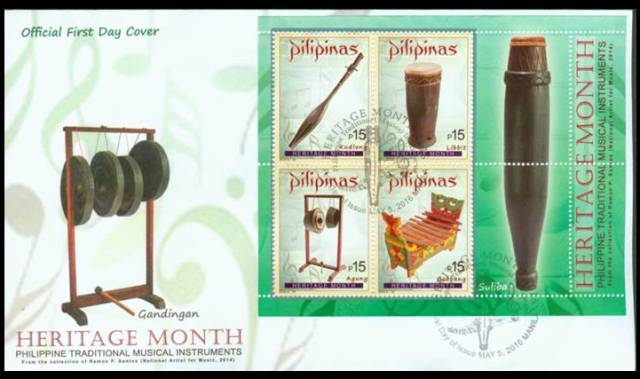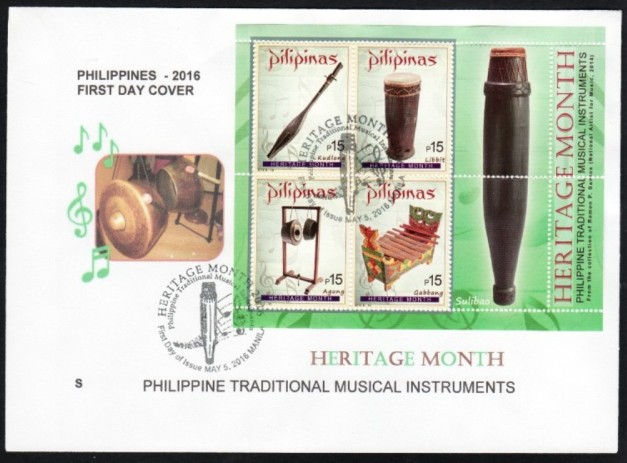2016, May 5. National Heritage Month: Philippine Traditional Musical Instruments
Litho Offset, Amstar Company, Inc., Perf 14
Se-tenant Blocks of 4, Miniature Sheets of 16; Souvenir Sheets of Four + 2 Labels
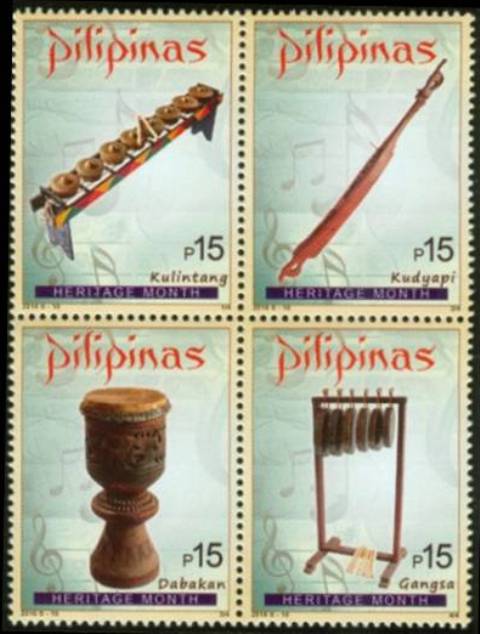
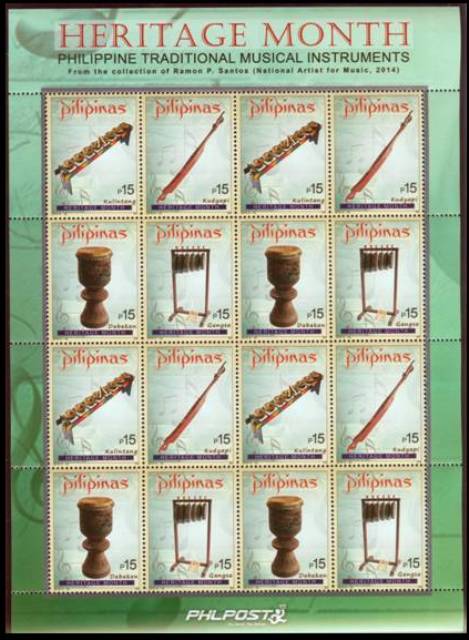
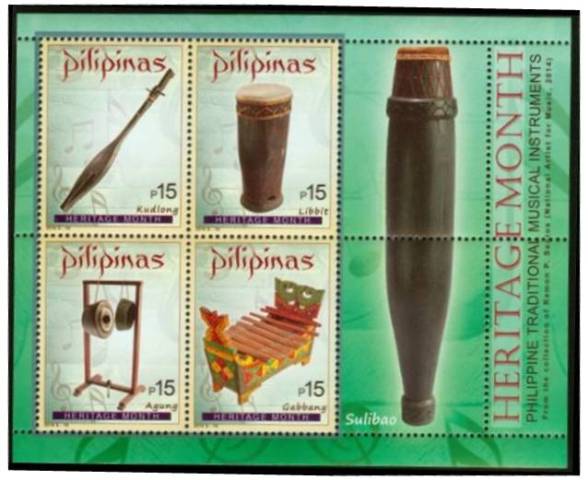
Se-tenant Blocks of Four (25,250)
15p Kulintang
15p Kudyapi
15p Dabakan
15p Gangsa
Miniature Sheets of 16 (6,312.50)
60p Souvenir Sheets of Four (5,000)
15p Kudlong
15p Libbit
15p Agung
15p Gabbang
Stamp Designer: Victorino Z. Serevo
Design Coordinator: Filipino Heritage Festival, Inc.
First Day Covers: Manila
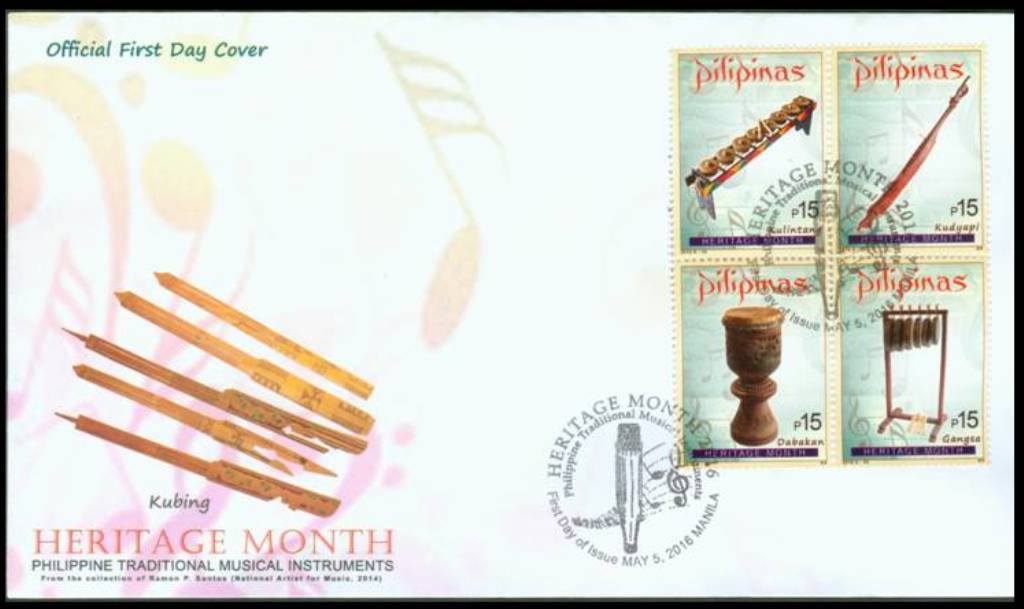
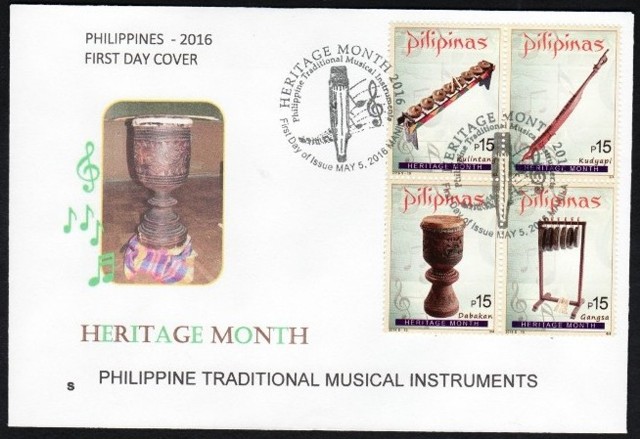
National Heritage Month: Philippine Traditional Musical Instruments
KULINTANG. An instrumental form of music composed on a row of small, horizontally-laid gongs that function melodically, accompanied by larger, suspended gongs and drums. As part of the larger gong-chime culture of Southeast Asia, kulintang music ensembles have been playing for centuries in regions of the Eastern Malay Archipelago—the Southern Philippines, Eastern Indonesia, Eastern Malaysia, Brunei, and Timor. Kulintang music is considered an ancient tradition that predates the influences of Hinduism, Islam, Christianity, and the West. In the Philippines, it represents the highest form of gong music attained by Filipinos.
http://www.newworldencyclopedia.org/entry/Kulintang
KUDYAPI. A Philippine two-stringed, fretted boat-lute. It is the only stringed instrument among the Maguindanao people, and one of several among other groups such as the Maranao and Manobo. It is four to six feet long with nine frets made of hardened beeswax. The instrument is carved out of solid soft wood such as that from the jackfruit tree. Common to all kudyapi instruments, a constant drone is played with one string while the other, an octave above the drone, plays the melody with a kebit or rattan pluck. https://en.wikipedia.org/wiki/Kutiyapi
DABAKAN. A single-headed Philippine drum, primarily used as a supportive instrument in the kulintang ensemble. Among the five main kulintang instruments, it is the only non-gong element of the Maguindanao ensemble. The dabakan is frequently described as either hour-glass, conical, tubular, or goblet in shape. Normally, the dabakan is found having a length of more than two feet and a diameter of more than a foot about the widest part of the shell. The shell is carved from wood either out of the trunk of a coconut tree or the wood of a jackfruit tree which is then hollowed out throughout its body and stem. The drumhead that is stretched over the shell is made out of either goatskin, carabao skin, deer rawhide, or snake/lizard skin, with the last considered by many dabakan practitioners as the best material to use. The main use for the dabakan in Maguindanao and Maranao society is as a supportive instrument in the kulintang ensemble, keeping the tempo of the ensemble in check. https://en.wikipedia.org/wiki/Dabakan
Gangsa. Indigenous to the cultures found in the mountain regions (the Cordillera) of the northern Philippines. The gangsa of the northern Philippines is a single hand-held smooth-surfaced gong with a narrow rim. A set of gangsa, which is played one gong per musician, consists of gangsa tuned to different notes, depending on regional or local cultural preferences. The number of gangsa in a set varies with availability, and depends on the tradition of a particular ethnic group of the Luzon Cordillera: Kalinga, Ifugao, Bontoc, etc.
http://pinoy-culture.tumblr.com/post/25454277347/gangsa-traditional-musical-instruments-from-the
On Souvenir Sheets:
Kudlong (Chordophone) – a two-stringed lute used by the Mansaka and Mandaya. Frets are located on the neck of the instrument.
Libbit (Membranophone) – a conical drum with a deer or goat skin head used by the Ifugao and played with a gong during harvest time under the rice granary.
Agung (Idiophone) – a larger, deep-rimmed gongs with sides that are turned in, used in Southern Philippines.
Gabbang (Idiophone) – a bamboo xylophone found in Southern Philippines among the Yakan, Sama, Tausug and Palawan. It consists of bamboo keys at graduated lengths mouned on a trapezoidal box. Number of keys varies among the different ethnic groups ranging from 3-22.
Sulibao (Membranophone) – a longitudinal slightly barrel-shaped hollowed out logs with deer skin heads on one end used by the Bontok and Ibaloi. Played with palms of two hands, the drums are combined with gongs and other instruments to form different types of ensembles.
-
Musical Instruments
